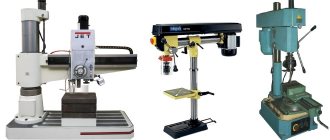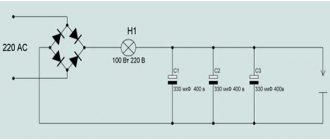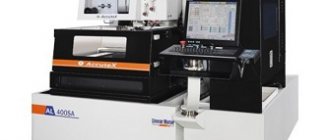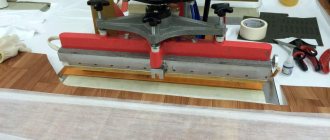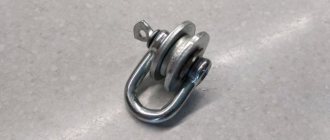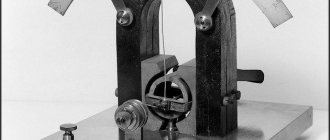Radial drilling machines are used for processing workpieces of large weight and dimensions in single and small-scale production: in repair production, shipbuilding and mechanical engineering.
The main advantage of vertical drilling machines is the ability to process parts at any point without reinstalling them. This saves time and increases accuracy, because... Reinstalling a large and heavy part is a time-consuming undertaking and may disrupt its alignment. Those. It is not the workpiece that moves, but the spindle relative to the workpiece.
Designation
According to the classification, ENIMS are designated as follows: the first number in the marking indicates the group “Drilling and boring machines”, the second - the type - “Radial drilling machines”, the third and fourth - the maximum drilling diameter. Letter – the machine was modernized. For example, 2B56 is a radial drilling machine with a maximum drilling diameter of 60 mm.
Modern imported models of machine tools do not have a designation standard - each manufacturer designates models according to its own standard. For example, Optimum classifies its radial machines into light (RB) and heavy (DR): RB6, RB8, DR5, DR6; Proma stands for heavy machine RV-32; Jet – JRD: JRD-460, JRD-720R, JRD-1100R.
The lack of a standard leads to confusion and complicates the selection of analogues.
Features and technical characteristics of the device
Radial drilling machines belong to the metal-cutting class of equipment and are intended mainly for mechanical processing of a wide variety of parts, both steel and non-ferrous metals.
This tabletop unit belongs to the second class equipment according to the accepted classification of all metal-cutting equipment.
Among the main characteristics of the popular models 2m55, 2k52, 2a554, ac2532, as well as 2n55 and 2532l, one can note the ability to drill at different angles.
Video:
Equipment of this class is primarily used for roughing, semi-finishing, and finishing processing of a wide variety of surfaces; its characteristics correspond to this type of work.
IMPORTANT TO KNOW: Tabletop CNC milling machines for metal for small-scale production
The 2k52 desktop machine and others can successfully work with both cylindrical and conical, as well as end and threaded types of surfaces of various types of metals.
The main working tools of this class of equipment are drills, countersinks, reamers, as well as a variety of taps.
In addition, when performing specific types of processing, a special tool can be additionally used.
Machines 2m55, 2k52, 2a554, ac2532, as well as 2n55 and 2532l have a distinctive feature, which is that they are mainly designed for processing internal cylindrical and conical surfaces in those parts that are quite large in size and irregular shapes.
Repair of workpieces on radial drilling machines is carried out in the most convenient way.
The part, before drilling, is rigidly secured on the work table in a special mount.
In this case, the cutting tool moves smoothly relative to the plane of the workpiece itself.
A tabletop machine of this type, regardless of its model, has high power characteristics, which makes it possible to carry out processing, including steel surfaces.
Due to its functionality, equipment of this class has found wide application in a variety of types of production, including automotive and aircraft manufacturing.
Layout
The equipment has a unique layout: a column and a table are installed on a stove. A traverse is attached to the column, moving along the column in a vertical position, and it also has the ability to rotate relative to the column by 360 degrees. A drilling (spindle) head is installed on the traverse, moving relative to the traverse in the horizontal direction. It is designed as a separate unit. If it needs to be fixed in a certain position, then there is a clamping mechanism for this purpose.
On the market you can find desktop radial drilling machines that are similar in layout to vertical drilling machines. Their main difference from the classic layout is the ability to move the table in the vertical direction instead of moving the traverse.
Vertical drilling machine Enkor Corvette 48
Optimum RB6T
Drilling machine. Types and device. Operation and Application
A drilling machine is equipment designed for processing holes in metal and other materials.
The device has a similar principle of operation to a hand drill, but has a more sophisticated design that allows for precise adjustment.
This equipment is produced in various modifications depending on its purpose. To ensure drilling, consumables are installed in the machine - drills, taps, reamers or cutters.
Where is the drilling machine used?
Drilling machines are common in production and household use. They can be found almost everywhere. Car enthusiasts, as well as professional mechanics and carpenters, often have such machines at their disposal. There is practically no repair company that does not have a drilling machine among its equipment.
The use of this equipment allows you to perform various functions:
- Drilling holes.
- Scan.
- Diameter expansion.
- Countersinking of the part.
- Thread cutting.
Machine device
Any drilling machine consists of an electric motor, a chuck for fixing the bits installed on the spindle, and an adjustment mechanism. Depending on the complexity of the design, different amounts of adjustments can be made.
The simplest machines allow you to process holes in one position only vertically.
More complex designs have an adjustable stand for fastening workpieces, which allows you to set them at the desired angle by making holes obliquely.
In drilling machines, rotation is often transmitted from the motor to the chuck not directly through the shaft, but using a drive belt. Another interesting design solution is that the frame for adjusting the drilling depth moves not the workpiece to the chuck, but the chuck with the motor to the surface being processed. Even the simplest machine design allows you to precisely adjust the processing depth.
Thanks to the rigid fixation of the shaft rotating with the attachment, parts are processed with high precision and without the formation of runout, as happens when using a hand drill.
In addition, the power of machines is significantly higher than that of hand tools, so they are able to work with thicker and heavier attachments. This ensures faster processing of parts.
Classification of machines by implementation
Based on their implementation, machines can be divided into four groups:
- Vertical drilling.
- Radial drilling.
- Horizontal drilling.
- Multi-spindle.
Vertical drilling machines are one of the very first to be used in production. They come in a variety of designs and are usually capable of machining holes up to 50mm in diameter.
This equipment allows adjustment only in the vertical plane. The part itself is fixed or laid motionless. A gear drive is used to raise or lower the spindle with chuck and drill. As a result, the vertically mounted motor, connected to the spindle via a belt, also moves.
The electric motor is usually protected by a casing that blocks the entry of chips.
Radial drills work on almost the same principle as vertical drills. The column for their fastening is made of a round shaft, which allows adjustment not only up and down, but also to provide horizontal movement.
In fact, using such equipment, you can adjust the lowering point of the drill on the machine itself, rather than moving the workpiece on a table or plate.
Often the radial installation weighs several tons, and is found only in large enterprises and workshops.
Horizontal drills are typically used to make deep holes. As a rule, this is heavy equipment that has a rail with a platform for laying the workpiece.
The design of the machine allows you to move the workpiece onto the drill or, conversely, direct the chuck with the motor to the workpiece. This allows you to comfortably work with workpieces of various weights and sizes.
Multi-spindles can perform multiple tasks. Each operation is done in stages. Such machines are difficult to confuse with other varieties. Their peculiarity is that they have several cartridges. As soon as one of them has completed the required amount of work, a quick adventure is carried out on the other, in which the required drill, cutter or reamer is attached.
Types of machines
Depending on the operating conditions and the specifics of production, radial drilling machines are divided into several types:
- general purpose;
- general purpose with rotation of the drilling unit;
- on the guides of the bed;
- mounted on rails;
- portable (mobile);
- wall-mounted
General purpose radial drilling machine General purpose radial drilling machine with rotating drill assembly Radial drilling machine on bed guides Radial drilling machine mounted on rails Portable radial drilling machine Wall mounted radial drilling machine
General purpose machines are used in repair shops and metalworking industries. They are stationary - they are installed once on the foundation and are no longer transferred during operation. The workpiece is placed on a table or on a foundation slab. The base plate contains a coolant tank with a pump to supply it to the cutting zone. The spindle head moves along the traverse in a horizontal plane, and the traverse moves in a vertical plane and around the column. Equipment with a spindle turning relative to a horizontal transverse beam in an angular direction belongs to the second type.
Radial machines are installed on bed guides for processing heavy and large-sized workpieces. Another variety of this type are machines mounted on a trolley, which is capable of moving along rails due to an electric drive.
Wall-mounted and portable radial drilling machines are used in shipbuilding and heavy engineering, and their main purpose is the processing of hard-to-reach parts with large dimensions: cases and castings.
Radial drilling machine: 2A554, 2K52, 2M55
Radial drilling machines are used to drill through and blind holes in metal or wooden parts, as well as to perform a number of auxiliary operations - countersinking, boring, reaming and threading.
This article provides information about radial drilling units. We will study their functional purpose, scope of application, design features and consider popular equipment models.
Purpose, functionality
Radial drilling machines are widely used in both mass and individual production to form holes in parts made of metal, cast iron and non-ferrous alloys. The main movement in equipment of this class is the rotational movement of the working tool - the drill, and its reciprocating feed.
Radial units are designed to work with large parts that are unsuitable for drilling on conventional vertical machines due to the laboriousness of moving the workpiece across the work table.
Unlike standard equipment, in radial mechanisms the part fixed on the table plane remains motionless, and the spindle with the working tool moves to the required position.
Kinematics
Spindle rotation is the main movement of the machine.
The movement of the spindle in the vertical direction is the feed movement.
Moving the traverse up and down along the column, moving the drilling head horizontally along the traverse, moving the traverse around the axis of the column - installation movements.
An example of a kinematic diagram of a radial drilling machine 2N55
The machines have a wide range of rotation speeds, drilling head speeds and mechanical feeds.
Work and operation
In devices of this type, the gearboxes and operating gears are located in the drill headstock.
Accordingly, all the main organs in units 2m55, 2k52, 2a554, as well as ac2532, 2n55 and 2532l are located directly on its front surface.
Video:
The main movement during which cutting is carried out in devices of this class is considered to be the rotation of the working tool used.
It receives the necessary rotational movement through a transmission directly from the electric motor, which also provides, if necessary, auxiliary movement of the working tool used.
IMPORTANT TO KNOW: Choosing a tabletop metal lathe
Before starting work, the parameters of the specified processing are set using special handles located on the gearbox.
Feed control occurs in exactly the same way. The main operating characteristics of the unit are described by several indicators.
First of all, what matters is the nominal diameter of the maximum value that can be processed with a drill.
The main number of the attached cone, which is located inside the spindle, is also taken into account.
The greatest movement of the spindle itself is also taken into account.
These devices also provide a different range of revolutions at which the spindle can rotate.
When operating drilling machines of this class, the number of steps responsible for the working rotation in the spindle must be taken into account.
Video:
The functionality of the machine is greatly influenced by the power of the electric motor used.
It is also worth noting that the cost of devices from this category is influenced, first of all, by the functional set, all its technological capabilities, as well as the technical condition.
Repair of a drilling machine should be carried out by professional craftsmen who are well versed in the structure and operating principle of units of this class.
When operating the unit, it is imperative to carry out regular maintenance.
This will help extend the life of the device and make it safe to use.
A prerequisite for working on devices of this class is strict adherence to safety regulations that every operator must follow.
In any case, a tabletop drilling machine of this class is considered reliable and quite functional equipment, with which you can perform high-quality processing of various metal surfaces.



